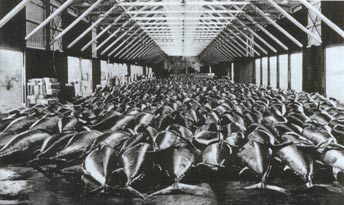Bluefin Tuna’s Future
by Jon Keller
|
In the United States, the name tuna generally conjures images of flaky white meat stuffed into a can of water and sold two-for-a-buck at the local supermarket. But thanks largely to Japan, tuna is now known as a delicacy; a marbled, red meat sold for high dollars on the sushi-sashimi market.
Despite the recent high prices of tuna (in 2001, a single fish sold for $174,000 at a Tokyo market), the fishermen have been steadily pushed from the market by a myriad of factors. Tuna fishermen up and down the east coast, from North Carolina to Maine, have been limited to a catch that is 65% less than what it once was, and lately they haven’t even been able to find that many fish. With such stringent conservation measures, where have the bluefin gone?
Early Commercial Fishing
Fishing for tuna started as long ago as the seventh millennium B.C., when the Atlantic bluefin was caught along the Mediterranean coast. The fishermen, mostly Phoenician, used hand lines and beach seines to catch the tuna, which were migrating to and from their warm Mediterranean spawning waters. Later, in the 16th century, a commercial industry developed around the bluefin, and canneries were set up along the coasts. Traps replaced traditional seines and hand lines and it’s estimated that the average yearly yield was between 7,000 and 30,000 metric tons (mt).
It wasn’t until the 1930’s that the purse seine replaced the trap, and the Nordic fleets, mostly Norwegian, began to catch more fish and bigger fish; their catches exceeding 30,000mt a year. By the 1960’s and ‘70’s, the fishery had expanded and juveniles were targeted in the West Atlantic. Hand liners, harpooners, trappers and rod-and-reel fishermen caught the giants, though the giant tuna fishery had not yet blossomed.
|

Tuna at auction in Denmark in 1940. Times have changed. Now recognized as belonging to the same stock, tuna stocks in the Western Atlantic are protected by better regulation until they migrate to the Eastern Atlantic. However, their food supply is being depleted by voracious midwater trawlers. —Dr. David Conover. Photo courtesy John Steffensen |
|
|
|
|
Where Once Great Ships
by Steve Cartwright
|
Buried in the muddy banks of the Medomak River, along with arrowheads and early pottery, are the old timbers of ways that sent great five-masted schooners on their way around the world.
These days Waldoboro is a quaint and quiet backwater, bypassed by Route One, a village that becomes a ghost town after dinnertime. Nineteenth century houses line Main Street, a drugstore and a pub occupy the brick buildings that were once a thriving downtown.
If there are ghosts here, they might be the offspring of the German immigrants who settled the place in the mid 1700s. These hardworking people built some of the greatest schooners to sail the seas. Breathtakingly big and beautiful vessels were launched in the shallow Medomak River estuary, an area now home to the largest clam landings on the coast. Though it’s mudflats now, the harbor was once deeper; the village once had hotels and a sail loft, a blacksmith shop, woolen mill, dance hall and mansions built by wealthy merchants of English Colonial ancestry.
continue
|
| The schooner Fannie Palmer with Storer’s Wharf and Waldoboro village in background ca. 1900. One of many big schooners built for the Palmers. This Waldoboro built ship was 2,258 tons, 300' and built by George Welt. Photo: Waldoboro Historical Society |
|
|
|
|
|
  
|
|

